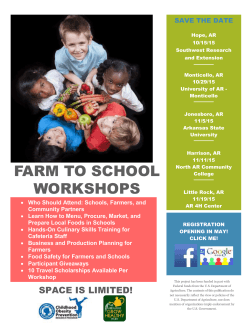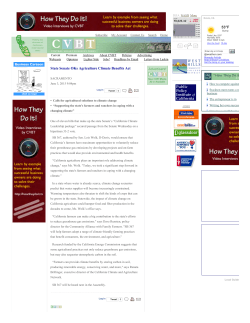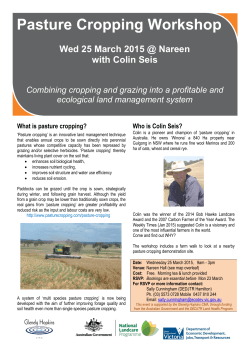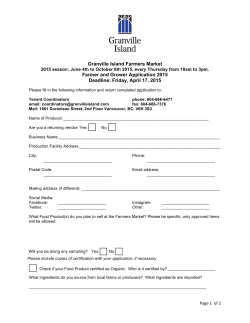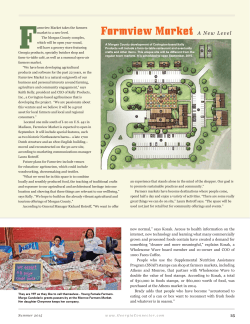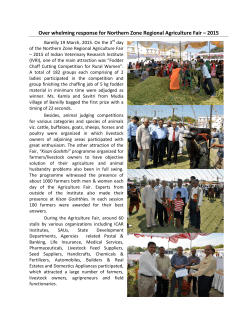
Crop and Pasture Report South Australia
Crop and Pasture Report South Australia 2015-16 CROP SEEDING INTENTIONS MAY 2015 Crop and Pasture Report - South Australia This is a bimonthly report prepared by Rural Solutions SA, for the Agriculture, Food and Wine Division of Primary Industries and Regions SA (PIRSA). Information current as of 6 May, 2015. © Government of South Australia 2015. ALL ENQUIRIES Dave Lewis Grains Account Manager Primary Industries and Regions SA (PIRSA) GPO Box 1671, Adelaide SA 5001 Telephone +61 8 8463 6696 Email dave.lewis@sa.gov.au DISCLAIMER PIRSA and its employees do not warrant or make any representation regarding the use, or results of the use, of the information contained herein as regards to its correctness, accuracy, reliability and currency or otherwise. PIRSA and its employees expressly disclaim all liability or responsibility to any person using the information or advice. SEPTEMBER MAY 2015 CROP AND PASTURE REPORT SOUTH AUSTRALIA PAGE 2 Table of Contents State Summary 4 District Reports 6 Western Eyre Peninsula Lower Eyre Peninsula Eastern Eyre Peninsula Upper North Mid North Lower North Yorke Peninsula Adelaide Hills, Fleurieu Peninsula & Kangaroo Island Lower Murray Northern Murray Mallee Southern Murray Mallee Upper South East Lower South East SEPTEMBER MAY 2015 CROP AND PASTURE REPORT SOUTH AUSTRALIA 6 7 8 9 10 11 12 13 14 15 16 17 18 PAGE 3 State Summary WEATHER • Rainfall for March ranged from average on Kangaroo Island, Fleurieu Peninsula and parts of the South East, to very much below average in parts of the Mid North and Mallee. • April rainfall ranged from below average in parts of the Lower South East to very much above average in other parts of the State, with some areas in the Upper North receiving the highest April rainfall on record. • Mean maximum temperatures for March were average to below average with minimum temperatures being average to very much below average in the Lower South East and Eastern Eyre Peninsula. • Mean maximum temperatures for April were below to very much below average in all districts. CROPS • Most districts received adequate rainfall during early April to allow seeding to commence mid-April. • The Upper South East has not received the good opening rains experienced in most of the State. Some farmers in this district have commenced seeding with marginal soil moisture. • The amount of stubbles burnt prior to seeding has increased on Eyre Peninsula, unchanged in the Mid North and Yorke Peninsula, and decreased in the Lower North. • There has been an increase in the amount of stubble windrow burning and a decrease in burning of whole paddocks. • The early break in most of the State has meant seeding has progressed at a leisurely pace, enabling weeds to germinate and ensuring particular crops and varieties are not sown too early. • Farmers have been steadily increasing the size and capacity of their seeding machinery so that large areas can now be sown relatively quickly. • The area likely to be sown to canola has fallen dramatically in some districts and across the State and will be down by at least 30%. This is due to canola’s poor price outlook and poor yields in recent years. • Canola has been replaced by pulse crops, oaten hay and some barley. • The area sown to wheat is likely to remain relatively stable with a slight increase in some districts and reduction in others. • There are high reported mice numbers in isolated spots on Western and Central Eyre Peninsula and Yorke Peninsula. Farmers in these areas are baiting immediately after seeding. • In some other districts mice numbers have increased in and around sheds but are in low numbers in paddocks. • Insect numbers are at relatively low levels in contrast to last season. • Despite good control of snails over the summer, there are still moderate to high numbers in some areas. Some farmers have baited soon after the opening rains but most will only bait vulnerable crops after seeding. PASTURES • At the end of April, pasture feed was in short supply with only minimal green feed available. • Farmers in most districts are supplementary feeding livestock hay and grain. • Many farmers sowed pasture feed in early to mid-April into dry or moist soils. Early sown pasture feed has emerged but is only growing slowly. SEPTEMBER MAY 2015 CROP AND PASTURE REPORT SOUTH AUSTRALIA PAGE 4 • Most livestock are in reasonable condition mainly due to the high levels of supplementary feeding. • Heavy supplementary feeding of sheep and cattle is continuing in the Upper South East but reserves of hay and grain are low. • If significant rain is not received in the Upper South East within the next six to eight weeks many producers will be forced to sell more livestock, including breeding animals. KEY LINKS TO OTHER INFORMATION Department for Environment, Water and Natural Resources - Soil and Land Condition monitoring: www.environment.sa.gov.au/Knowledge_Bank/Science_research/Monitoring_evaluation_analysis/Monitori ng/Soil_and_land_condition Bureau of Meteorology - Weather and rainfall observations: www.bom.gov.au NOTES ON CALCULATION OF CROP ESTIMATES Crop estimates for the current year assume average rainfall and temperature conditions for the remainder of the growing season. Grain estimates are for total grain production and include grain delivered for immediate sale and warehousing plus grain retained on farm for seed, feed and future sale. Hay estimates are for total hay production and include all pasture, cereal and other crops cut for hay, both dry-land and irrigated. The estimates are based on information provided by Rural Solutions SA District Reporters from a variety of sources and are updated throughout the season as conditions change and further information becomes available. They are intended to provide an indication of crop potential at the time the report is prepared. The estimates are updated using ABS census data as available. SEPTEMBER MAY 2015 CROP AND PASTURE REPORT SOUTH AUSTRALIA PAGE 5 District Reports Western Eyre Peninsula WEATHER • March rainfall was average in the coastal districts and below average inland. • April rainfall was very much above average rainfall in the Far West and above average in the remainder of the district. • Mean maximum temperatures were average to below average in March and very much below average in April. CROPS • There is adequate soil moisture for sowing but subsoil moisture levels are still low. • Dry conditions to the middle of April resulted in low numbers of summer weeds which left most paddocks reasonably weed-free for farmers to begin sowing. • Low levels of stored subsoil moisture and poor returns from canola in recent years are expected to result in a reduction of the area sown to canola this season. • There is likely to be an increase in the area sown to legume break crops, with the area of field peas and lupins expected to return to the long term average. • A large amount of stubble burning was undertaken in early April. Most of this was burning of header rows to manage stubble loads and weed seeds. • Some paddocks were completely burned where farmers were concerned about the potential for high snail numbers to damage canola or pulse crops. • Low nitrate levels have been recorded in pre-season soil tests indicating limited nitrogen mineralisation due to dry soil conditions. Fertiliser nitrogen will need to be applied at sowing for good early crop vigour. • Medic and vetch were sown following early April rains to re-establish pastures and act as break crops. Most farmers are applying legume inoculant with the seed to build soil rhizobia populations. • The area sown to cereals is expected to be about average. • A large amount of oats and some barley were sown in mid-April for early feed; however most of the cereal crop will not be sown until early May. • Most farmers achieved good control of snail numbers by prickle-chaining and cabling stubbles in summer. Many vulnerable crops will be baited to provide additional protection against snail damage. • The early opening rain has resulted in a good germination of weeds which will enable effective weed control before seeding. • High mice numbers are present in isolated hotspots around Wirrulla and Mudamuckla. Large numbers are also being reported around sheds at Pt Kenny and Streaky Bay. Early-sown and vulnerable crops such as canola are being baited. PASTURES • Paddock feed levels are very low and many farmers have been supplementary feeding stock since early March. • Pastures and cereals were sown for feed following rains in mid-April and these have emerged. • Livestock are in excellent condition. SEPTEMBER MAY 2015 CROP AND PASTURE REPORT SOUTH AUSTRALIA PAGE 6 Lower Eyre Peninsula WEATHER • March rainfall was below average in most of the district. • April rainfall was very much above average rainfall across the district. • Mean maximum temperatures were average in March and below to very much below average in April. CROPS • A large amount of gypsum and lime was spread in March and early April to improve soil condition on responsive soils. • There was a large amount of residue burning undertaken in early April to manage stubble loads and weed seed numbers prior to seeding. • Continued good sowing conditions enabled sowing of canola and pulses during late April. • These crops have germinated quickly, but there has also been a high germination of weeds, particularly marshmallow, which may be difficult to control in conventional canola varieties. • The area sown to canola is expected to be reduced by 20% this season due to poor returns from canola in recent years. • Farmers are planning to increase the area sown to beans and lupins with a slight increase in the barley area. • Continued damp and mild conditions have resulted in a good germination of weeds and will provide a good opportunity for weed control before sowing cereal crops. • Dry conditions over summer have limited nitrogen mineralisation so farmers will need to apply adequate nutrition at seeding to ensure good early crop vigour. • There are reports of lucerne flea damage on early germinating crops and pastures. Red legged earth mite has also been reported. In general, insect pest numbers are generally low. • Snail populations were reduced by stubble management activities over summer. Farmers are still baiting vulnerable crops such as canola and legume to protect against damage. PASTURES • Low levels of paddocks feed have necessitated supplementary feeding of stock during this period. • Mid-April rains provided opportunities to re-establish annual pastures or to sow feed. • Early rain and mild conditions have resulted in rapid germination and growth of annual pastures. • Livestock are in excellent condition. SEPTEMBER MAY 2015 CROP AND PASTURE REPORT SOUTH AUSTRALIA PAGE 7 Eastern Eyre Peninsula WEATHER • March rainfall was below average across the district. • Rainfall for April was average in the north to very much above average rainfall in the south. • Mean maximum temperatures were average to below average in March and very much below average in April. CROPS • Stored subsoil moisture levels are low in the Kimba and Buckleboo districts which did not receive the earlier April rains. • Stored subsoil moisture levels are moderate throughout the Cleve district which received over 75 mm for the month. • A large amount of residue burning was undertaken in early April to manage stubbles prior to seeding and reduce the amount of viable weed seeds. • Canola and legumes were sown late in the month. • The area of canola is expected to be reduced from recent years due to its poor returns. Farmers are increasing the area of legume break crops. • A few farmers are experimenting with small acreages of beans and lentils. • Sowing of cereals began in early May. The area of cereals is not expected to change significantly. • Early rains have resulted in a good germination of weeds enabling effective knock-down herbicide applications prior to sowing. • Some farmers have expressed concern regarding potential herbicide residues given the dry conditions over summer and have revised their crop selection to minimise damage. • Dry conditions have limited soil nitrogen mineralisation so most growers are applying fertiliser at sowing to ensure there is adequate nitrogen for good early crop vigour. • Mice activity is generally low but there are pockets of high activity particularly in Central Eyre Peninsula, where farmers are baiting immediately after seeding. • There are reports of higher snail numbers than normal and some farmers are baiting vulnerable crops such as canola and pulses. • There have been isolated reports of lucerne flea damage on germinating pastures but insect pest numbers are generally low at present. PASTURES • Paddock feed levels are very low and farmers are providing supplementary feed for stock. • Farmers have increased the area sown to vetch and oats to replenish hay supplies used over the summer and autumn. • Some farmers began sowing pastures and early feed following rains in mid-April. • There has been a good germination of early sown pastures and cereals sown for feed. • Livestock are in excellent condition. SEPTEMBER MAY 2015 CROP AND PASTURE REPORT SOUTH AUSTRALIA PAGE 8 Upper North WEATHER • March rainfall was below average in most of the district and very much below average in the northern part of the district. • April rainfall was very much above average in most of the district with a pocket in the north receiving their highest April rainfall on record. • Widespread rain in the second week of April brought heavy falls to the northern part of the district with several recordings of 100 mm or more. • Mean maximum temperatures were average to below average for March and below to very much below average for April. CROPS • Excellent rains in early April with good follow up rains later in the month has enabled seeding to get underway across the district. • Despite the early start some farmers have delayed seeding, waiting for weeds to germinate and to avoid frost damage. • Many farmers have already sown vetch, oaten hay and canola and had started to sow wheat by the end of April. • Weeds have been very slow to germinate and farmers have had to wait a few extra days to ensure adequate control where grassy weed levels are high. • There is a big variation in the area sown on individual farms, with some farmers just starting and others already 50% or more complete. • An increased tonnage of gypsum (as a sulphur fertiliser and soil conditioner) and lime (to neutralise soil acidity) were spread during March and April. • Minimal stubble burning has occurred throughout the district. Most farmers only burned stubble windrows. • The area sown to canola is likely to be reduced by 15 to 20% compared to last season. This might have even been lower if the good opening rains had not occurred. • The area sown to legumes will be similar to last year with a slight increase in the area of beans. • The area of oaten hay has increased in response to the good prices currently being offered. • Insects are at low levels compared to the extremely high levels seen last year. • Isolated pockets of snails have been baited. Some farmers are baiting fence lines to stop snails moving in from adjacent areas. • Mice are at relatively low numbers in paddocks but have begun to build up in sheds. • There are adequate supplies of fertiliser and chemical, despite the early break to the season. • Locusts migrated into the Upper North during mid-March. Most have not laid eggs due to the lack of green feed. PASTURES • Pasture feed is in short supply with only minimal green feed available by the end of April. • Many farmers started dry-sowing pasture feed before the rain. This early-sown pasture feed has emerged but is only growing slowly. • A few farmers have spread fertiliser on their hills grazing country for the first time in many years. SEPTEMBER MAY 2015 CROP AND PASTURE REPORT SOUTH AUSTRALIA PAGE 9 Mid North WEATHER • Rainfall was below to very much below average for March and above to very much above average for April. • The western part of the district only received light falls of rain in early to mid-April, while the eastern part of the district received heavy falls. • Mean maximum temperatures for March ranged from below average in the north to average in the south. April maximum and minimum temperatures were below average across the district. CROPS • Seeding commenced in the eastern part of the district in mid-April. • By the end of April the whole district had received sufficient rain to commence seeding. • There is adequate stored soil moisture for most growers to complete seeding. • The area of stubble burning has been slightly above average with many farmers trying to burn stubble rows with mixed success. • Most pasture feed was sown early with some sown into dry soil. • Seeding was approximately 10% complete by the end of April with beans, lupins, canola and some oaten hay. A few farmers had started sowing wheat. • Farmers will delay sowing peas and lentils, due to the high risk of disease. • The remainder of the oaten hay will be sown later to help stagger the maturity for cutting later in the season. • Weeds have been very slow to emerge and most paddocks were only just starting to become green at the end of April. • The area sown to canola is likely to fall by 50% compared to last year. • There is likely to be increases in oaten hay and slight increases in the area of wheat and barley. • Snail numbers are at moderate levels with some farmers baiting early. Most will monitor numbers and only bait after seeding if necessary. • There are mice present in some paddocks and farmers have either already baited these paddocks or plan to bait them immediately after seeding. PASTURES • Most farmers are supplementary feeding livestock due to low levels of pasture feed. • There is very little green feed available and growth has been very slow due to below average temperatures. SEPTEMBER MAY 2015 CROP AND PASTURE REPORT SOUTH AUSTRALIA PAGE 10 Lower North WEATHER • Rainfall was below to very much below average during March and above average for April. • Mean maximum temperatures were average in March and below average during April. CROPS • There has been little complete burning of stubbles across the district with farmers opting to burn stubble windrows where possible, mainly to reduce ryegrass seed numbers. • Seeding commenced in mid-April with farmers sowing canola, beans and longer-season wheat varieties first. • By the end of April farmers were sowing oaten hay and earlier-maturing wheat varieties (mainly Mace). • Most farmers will delay sowing field peas and lentils until mid-May to reduce the risk of disease. • Weeds have been slow to emerge, however as weed populations are generally low, farmers are using pre-emergent herbicides (Sakura® and Boxer Gold®) on most crops rather than wait and use post-emergent herbicides. • In paddocks where ryegrass populations are high some farmers are using double knock-herbicide applications to achieve good control. • The majority of farmers sowing Mace wheat are using fungicide-treated fertiliser in-furrow to provide early protection against stripe rust. • The area sown to canola is likely to be down significantly compared to last season, due to its price outlook and poor yields achieved over the last few seasons. • Aphid numbers are at low levels compared to last year, greatly reducing the likelihood of Beet Westerns Mosaic Virus causing serious damage to canola crops this season. • The area of wheat will increase with more wheat sown into wheat stubbles. • High levels of Portuguese millipedes have been found in isolated paddocks and these have been sprayed before seeding to control numbers. • Mice are at relatively low levels across the district in both paddocks and sheds. PASTURES • There has been a good germination of medic in pasture paddocks but growth has been very slow. • Lucerne flea has started to build up in some medic pastures and will need to be controlled to avoid damage. SEPTEMBER MAY 2015 CROP AND PASTURE REPORT SOUTH AUSTRALIA PAGE 11 Yorke Peninsula WEATHER • Rainfall for March ranged from average in the south to below average in Central and Northern Yorke Peninsula. • April rainfall was average in the north to above average in Central and Southern Yorke Peninsula. • The mean maximum temperature was average to below average for March and below average for April. CROPS • Some of the soil moisture from summer rains has persisted until now, especially on the sandier soils. • The early April rain resulted in the germination of weeds prior to seeding, allowing good weed control and reduced reliance on pre-emergent herbicides. • Stubble burning of approximately 5% of paddocks on northern Yorke Peninsula and around 12% of southern Yorke Peninsula occurred in March and April. • Some burning of whole paddocks was done to reduce stubble loads, but most was confined to windrows or chaff cart heaps, targeting weed seeds as well as reducing pests. • Sowing started on YP in the middle of April with pastures and canola sown first, and is now in fullswing at a time regarded as ideal for maximising yield potential. • Mice numbers are high in some paddocks mostly around Maitland on Central Yorke Peninsula and Mundoora on Northern Yorke Peninsula. • Snail numbers are high and baiting started after the rains in early January, with the most successful baiting control occurring since the rains in early April. Good control was achieved through burning of paddocks with high snail numbers early in April. • Lucerne flea has been reported on medic pastures in the Kulpara area. • Canola will be down 20% due to pest and disease problems last year, as well as a lower price. • Between 5 to 10% more lentils are expected to be sown across the Yorke Peninsula this year, due to their high returns achieved in recent years. • The area sown to wheat is likely to reduce slightly with wheat-on-wheat being replaced by barley, due to the high barley price and lack of subsoil moisture in most areas. • The areas sown to barley will increase by 5 to 10% and the oaten hay area will also increase slightly this reason. • The area sown to chickpeas will also be down 5%. PASTURES • There is very limited pasture feed remaining with farmers maintaining stock condition by supplementary feeding hay and grain. • Sheep grazing stubbles removed some of the grain on the ground that can promote mice numbers. SEPTEMBER MAY 2015 CROP AND PASTURE REPORT SOUTH AUSTRALIA PAGE 12 Adelaide Hills, Fleurieu Peninsula & Kangaroo Island WEATHER • Rainfall was average to below average for March and average to above average for April. • Rainfall for the three month period of February to April was around the average for most of the region, below average for the north coast of Kangaroo Island and above average for the south-east of the Fleurieu Peninsula. • Mean maximum temperatures were average for March and below average for April. CROPS Central Hills/Fleurieu • Good early rain in April enabled a start to seeding but more is required to replenish soil moisture reserves after the long dry spring, summer and early autumn. • The area sown to canola will be reduced, possibly by 10 to 15% and replaced by beans, lupins and vetch hay crops. • The area sown to wheat and barley will remain the same. • More hay crops of all types will be grown to replace the fodder reserves depleted by several dry seasons. • There have been no significant reports of pests or diseases. Kangaroo Island • The majority of the island received enough rain at Easter and in subsequent showers to consider it the break to the season. • The north coast region has received below average rainfall. • Some farmers commenced seeding on 20 April. • There is likely to be a reduction in the area sown to canola due to the commodity’s poor returns. • There are high numbers of vegetable weevil present and this could result in damage to emerging canola crops. PASTURES Central Hills/Fleurieu • Pasture availability generally is poor and the early season break has prompted plant germination which will need ongoing rain to keep it growing. • Livestock condition is average to below average, particularly lambing ewes which have not been able to maintain sufficient body weight through a very dry period, despite being supplementary fed for many months. • There have been reports of some lamb losses due to poor ewe condition. Kangaroo Island • There has been a good germination of pastures on the south coast and centre of the Island but livestock will still need supplementary feed. • The north coast has not received enough rain to germinate pastures. • Livestock are in average condition, largely due to high levels of supplementary feeding. SEPTEMBER MAY 2015 CROP AND PASTURE REPORT SOUTH AUSTRALIA PAGE 13 Lower Murray WEATHER • Rainfall was below average for March and above to very much above average (more than double) for April. • Mean maximum temperatures were average for March and below average for April CROPS • Across the district, particularly in areas close to the ranges, April rainfall has resulted in excellent soil moisture for seeding, which will carry through well into the growing season. • Seeding of feed paddocks, canola and some pulses commenced in mid-April, and most farmers have started sowing their cereal crops. • Canola sowing intentions appear to be 50% less than last year’s area, with increased areas of vetch, peas and barley planned to be sown this year. • So far this seeding period has gone smoothly, with minimal delays, good weed germination and suitable conditions for weed control. • Active mice holes are present in paddocks but numbers are not considered high enough to be a problem across the district at this stage. PASTURES • Generally pasture and stubble feed levels have been low through autumn, requiring supplementary feeding of hay and grain to livestock. • Medics have germinated well in pasture paddocks but it is expected that supplementary feeding will have to continue in the coming months while pastures get established. • Livestock are generally in reasonable condition. SEPTEMBER MAY 2015 CROP AND PASTURE REPORT SOUTH AUSTRALIA PAGE 14 Northern Murray Mallee WEATHER • There was very little rainfall recorded during March with falls being below to very much below average. • April rainfall was very much above average (double) in the northern part of the region and above average for the mid Mallee. • Mean maximum temperatures for March were average and below to very much below average for April. CROPS • Widespread rains during April have resulted in a very good and timely opening to the season. • Seeding is well under way, with most no-till farmers now commencing seeding according to a target date (mid-April), rather than waiting for opening rains. • Pasture feed paddocks; canola and some pulses have been sown, with most farmers well into cereal seeding by the end of April. • There has been a strong move away from sowing canola this season, due to price, pests, diseases and previous crop failures. The canola has been replaced by vetch and barley. • The area sown to triticale has greatly decreased over the last decade across this region and is now only considered a minor crop. Much of this area has been replaced with barley. • There has been a good germination of grassy weeds, which are being controlled before seeding. • While there are numerous mice holes in some areas, they are not thought to be a significant concern across the district. PASTURES • Pasture and stubble feed has been fairly scarce through autumn, requiring supplementary feeding of hay and grain. • While there has been some good medic germination, and paddocks sown for feed, it is expected that stock feeding will have to continue in the coming months until these paddocks become well established. • With many sheep flocks lambing at present there has been an effort to co-ordinate fox control in many districts, due to the high fox numbers. Farmers are reporting very high numbers of baits taken. • Good lamb prices are providing excellent income for mixed farmers this year. SEPTEMBER MAY 2015 CROP AND PASTURE REPORT SOUTH AUSTRALIA PAGE 15 Southern Murray Mallee WEATHER • Almost no rainfall was recorded in the Southern Mallee for March, following a very dry February. • April rainfall has generally been above average. • Mean maximum temperatures were average to below average for March and below to very much below average for April. CROPS • Rains in late March and April resulted in reasonable soil moisture for seeding, while generally not completely filling soil profiles. • Seeding is well under way in the Southern Mallee. Some feed paddocks, canola and some pulses have been sown with most farmers starting to sow cereals by late April. • There has been a strong move away from sowing canola this season, due to price, pests, diseases and previous crop failures. This appears to have led to larger areas of lupins, vetch and barley being sown across the region. • The area sown to triticale has greatly decreased over the last decade across this region and is now only considered a minor crop. • There has been a good germination of grassy weeds that have been controlled during crop preparation. • While there are a few active mice holes in paddocks, they are not thought to be in high enough numbers across the district to cause significant crop damage. PASTURES • Pasture and stubble feed has been at low levels since January and there has been a strong requirement for supplementary feeding of hay and grain all year. • While there has been a good germination of medic in some paddocks and good emergence of early sown feed, the growth of these has been slow and supplementary feeding will need to continue in the coming months until pastures become well established. • The supplementary feed has maintained livestock in reasonable condition with reasonable to good prices being obtained for them. SEPTEMBER MAY 2015 CROP AND PASTURE REPORT SOUTH AUSTRALIA PAGE 16 Upper South East WEATHER • Rainfall was average to below average for March and average for most of the district in April. • Rainfall for the 6 months up to the end of April has been below average. • Mean maximum temperatures were below average for March and below to very much below average for April. CROPS • Some areas received sufficient rain to be considered the opening to the season however other parts of the district require further rain. • There is no significant rainfall forecast in the short term. • Due to the continuing dry conditions, some paddocks that were planned to be sown to canola will now be sown with beans, other legumes or pastures. • The dry conditions combined with low canola prices will result in at least a 25% reduction in the area of canola sown. • Other crop types will be sown as planned, although some producers are considering reducing crop area depending on rainfall in early May. • Dry sowing has begun of some canola but most of the crop sown has been beans. • Little spray topping was done due to the dry conditions last year which may result in some weed problems in pasture and crop paddocks this year. • Knock-down herbicides have been applied to less than half of paddocks as there has been little germination. On properties where enough rain fell for weeds to germinate, knock-down herbicides have been applied to control capeweed and barley grass. • Hay paddocks that would be traditionally grazed before cutting for hay will not be grazed this year due to the late break and a forecasted early finish to the season. • Short-season growing varieties are being sown where possible. • Many producers have borrowed money to purchase feed and sow their 2015 crops. PASTURES • Most pasture paddocks are bare and some farmers have erosion problems which they have never had to deal with before. • Isolated areas have received enough rainfall to germinate pastures, particularly paddocks that have not been over grazed. The early January rain germinated sub clover reducing the seed bank. • A large amount of pasture has been sown to maximise the chance of early pasture feed. This has mostly been cereals and some clover. • Livestock condition has begun to deteriorate with cows starting to calve and ewes lambing, with reports of high ewe and lamb mortality on some properties. • Many lucerne stands and pastures have been grazed hard and will take a long time to recover. • Heavy supplementary feeding of sheep and cattle is still underway but feed reserves of hay and grain are low as many producers had only budgeted for high levels of supplementary feeding to April or May. • If significant rain is not received within the next 6-8 weeks many producers will be forced to sell more livestock including breeding animals. SEPTEMBER MAY 2015 CROP AND PASTURE REPORT SOUTH AUSTRALIA PAGE 17 Lower South East WEATHER • Rainfall was average during March and average to below average for April. • Mean maximum temperatures were below average for March and April. • Mean minimum temperatures were very much below average during March and April. CROPS • Rain in mid to late April has enabled cropping preparations to progress. • The area of canola has been reduced by 25%, due to the poor price of canola. • Canola and long-season wheat varieties with grazing potential were sown in late April. • Slugs, snails and red legged earth mite are present across the district and will need to be controlled to avoid crop damage. • In paddocks that have been heavily grazed, barley grass and cape weed are worse than normal. PASTURES • There has been a shift to sown annual pastures to improve production. • Some clovers have germinated and are actively growing, with a good germination of most pasture across the district. • There is now sufficient green pasture feed for sheep and supplementary feeding has either stopped or been greatly reduced. • Cattle are still being heavily supplementary fed. • Ewes are lambing and cows are calving. • There have been several cases reported of grass tetany and milk fever affecting cattle. • Livestock are in average to good condition. SEPTEMBER MAY 2015 CROP AND PASTURE REPORT SOUTH AUSTRALIA PAGE 18
© Copyright 2025

